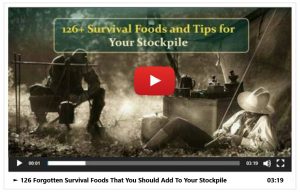Prepping isn’t an easy endeavor but modern preppers have it easier compared to those who experienced World War II (WWII).
Back in the early 1940s, people had to survive on war rations, which would have made feeding a large family difficult, especially if you were on a limited budget. But despite these difficult times, people endured and modern preppers can learn five important food storage lessons from people who lived through WWII.
In 1939, America still hasn’t experienced the horrors of World War II and citizens didn’t think they had to think about survival food storage or emergency preparedness like modern preppers.
The United Kingdom didn’t ration food until January 1940 while America only started rationing food until 1942. The suggestion to store food may have seemed strange to people living in 1939, but by the time America was fully involved in WWII, the practice would benefit many people.
► Medieval Lessons: The Most Powerful Natural Painkiller That Works Like Morphine That You Can Make at Home.
Here are five important WWII lessons about food storage to remember and practice before SHTF:
You can never have too much
Wherever state you live in, remember that you can never have too many of the right foods.
As a prepper, you should build a food stockpile and start a home garden. This ensures that you have access to both shelf-stable items and fresh fruits and vegetables.
Stock up on foods that will last a long time and can be used in different dishes. You also need to learn how to cook from scratch.
Here’s a list of food that you should stock up on before the stores run out when SHTF:
- Beans and lentils
- Canned fruits (Like apricots, cherries, peaches and pears.)
- Canned meat (Such as corned beef, salmon and tuna.)
- Canned soups
- Canned vegetables (Such as beans, beets, corn, peas and tomatoes.)
- Cereals
- Condiments
- Cooking oils
- Couscous
- Crackers
- Dairy and milk (Like condensed milk or coconut milk.)
- Flour
- Jams
- Jellies
- Nuts and seeds
- Oats
- Pasta
- Peanut butter and other nut butters
- Powdered eggs
- Powdered milk
- Rice
- Spices
- Sugar
- Tea and coffee
- Tomato sauce and paste
- Whole grains
►Educate yourself: The Lost Super Foods – 126 Forgotten Survival Foods That You Should Add To Your Stockpile. Watch the vide below:
If you want to try growing your own food, here are some plants that are perfect for a survival garden:
- Beans
- Beets
- Berries
- Cabbage
- Carrots
- Corn
- Cucumbers
- Garlic
- Kale
- Lentils
- Melons
- Onions
- Peas
- Peppers
- Potatoes
- Spinach
- Squash
- Sweet potatoes
- Tomatoes
- Various herbs
Build up your food storage supply now, not after rationing starts
Don’t get complacent. While the threat of war may seem like something impossible in these modern times, preppers know that it’s important to be ready for anything, such as natural disasters or long-term power outages.
If you are worried about your finances, start building your stockpile by purchasing an extra can of beans or tuna when getting the groceries. Keep doing this and soon, you’ll have enough extra food for a least one week.
In time, you will have enough for several weeks or even months. Remember, you don’t need to so spend all your money on extra supplies if you can’t afford it and buying extras when you can is more manageable.
Keep your stockpile a secret
Food was rationed during WWII, but if you were prepared before SHTF, food supplies will be one less thing to worry about.
Now, if your neighbors come to you asking for help in a survival scenario, give what you can spare but don’t talk about your stockpile to deter others from attempting to loot your house when SHTF.
► How to Build An Underground Cellar: All You Need to Know. Video Below:
If you have extra money, invest in other necessities
Wartime food storage wasn’t just about food. Back in the day, people also spend their money on important supplies that they couldn’t grow, make, or barter for.
If you have a large family, you may benefit from stocking up on other supplies like alcohol or tools so you can trade for other items that you will need when SHTF like clothing for your kids. You will also need to stock up on other essentials like prescription medication, pet food, or cleaning supplies.
https://rumble.com/embed/voruh4/?pub=jqf7z
Our mission to champion democracy, freedom of speech, and patriotic values relies on the support of dedicated individuals like you. Your contribution is vital in helping us provide insightful analysis, uncover pressing issues, and inspire positive change in our nation.
Join us in our commitment to making a difference. Every donation counts and empowers us to continue our work in advocating for the values we hold dear.
Thank you for being a crucial part of our journey.

I’m a 33-year-old writer and the founder of World Reports Today. Driven by the timeless principles of democracy and freedom of speech, I use my platform and my writing to amplify the voices of those who uphold these ideals and to spark meaningful conversations about the issues that truly matter.








